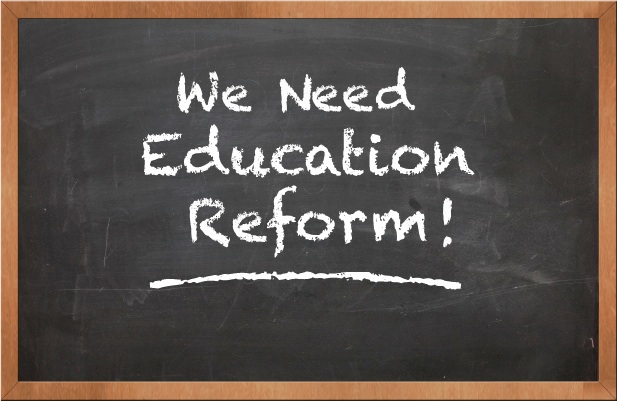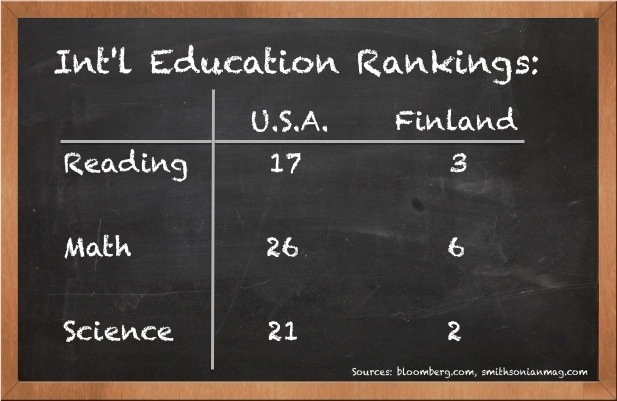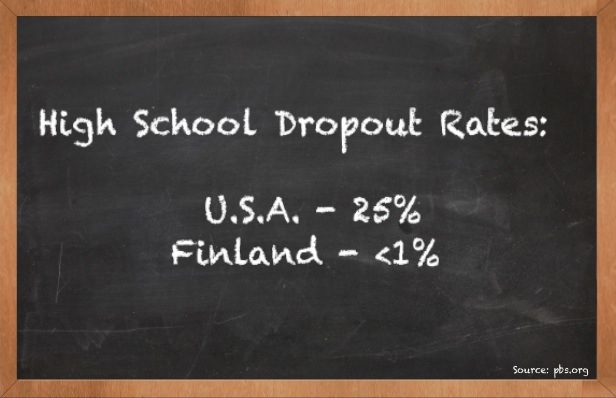To repair America’s broken education system, follow Finland’s model
February 19, 2014
Let me point out a fact that people know but fear to admit: America’s education system is broken. Decades of education policy failures, decades of political involvement, and decades of educational miscommunication and misunderstanding has reduced it to what it is today. Our students are ranked 21st in the world even though we spend more on education than most nations. Finland, on the other hand, spends 30% less than America and yet is ranked number one, or within a few places of it, in mathematics, reading, and the sciences. Why is that? Well, one nation is obsessed with testing and one is obsessed with teaching innovation; take a guess at which one is which.
From early on, we in America are introduced to standardization. Our schools teach to a curriculum handed down by politicians, who have little to no knowledge of how to properly educate, and the abilities of the students are measured through testing. As we go up through the grades, the emphasis on testing grows stronger until there is literally no other way to measure student progress. However, this strong adherence to testing has managed to throw out progress. I have always wondered that if tests were meant as a measurement of ability, why are there review sessions the day before? Why is it that standardized tests that are meant to measure progress (HSPA, NJASK, etc.) are now prepared for beforehand, if not for the sole goal of scoring high? It has gone from “educating the future” to “fake it till you make it”. In place of stimulating curiosity (which is the driving force behind learning for children and teenagers) is cramming down test-taking strategies. In place of trying to instill lasting knowledge is trying to have students score high on the next exam, while knowing that the knowledge will be disposed of afterwards. The greatest irony in all this is that all of this effort, this tremendous national movement, has yielded poor results. But what is even worse is that government funding policies are still based off of test scores with no real attempt to change. School systems, knowing that scores on standardized tests will determine the amount of money they receive from the government for a fiscal year, have a real incentive to “teach to the test” and not commit to a broader range of subjects. This results not only in a narrow curriculum but also creates a wide educational schism by paying some teachers better than others. This “measure of progress” is, at its very core, a fund distribution system that is easily gamed and is unsustainable for future progress.
Now a view of Finland. Finland’s education system is completely different. There is no standardized testing except at the end of the student’s high school career. Educational funding is distributed equally among all systems, not prioritizing high performing districts. In addition, one of the most glaring differences is the emphasis on teaching ability over testing in Finland. There, all teachers must know their own subjects and must complete a fifth-year master’s degree at one of the eight top universities in the country, with everything paid for by the government, making the occupation hold similar esteem as doctors and lawyers. This contrasts sharply with the United States, where in some places anyone can hold a teaching post, no matter how incompetent or with what educational degree. In addition, national and provincial curriculums were replaced by guidelines designed by educators and individual teachers. Even though there are objectives, how to reach them is up to the teacher, unlike here where it is decided by a boardroom of politically-focused minds hundreds of miles away.
These five factors–localized education, emphasis on quality, equal distribution of resources, high incentives, and curriculum development by actual educators–are what drive Finland to the top. For teachers in Finland, it is not a job but a passion. There is actual incentive for teachers to find the best way to get through to their students, besides writing things on a white board. There is incentive for them to find ways to deal with problem children, such as providing close support specifically targeted at individuals, instead of sending them to a remedial class and making them think themselves inferior. All of this allows standardized testing to become insignificant and the crazy yet unsurprising thing is that it is working. Our dropout rate is at 25%, as much as 60% in some areas of this country, while the dropout rate in Finland is less than 1%. Not only are they able to produce educated students through a multifaceted and innovative system without testing but they manage to keep the students in schools and onto universities. In Finland, the students are not seen as statistics on a chart but as the actual future of the nation.
The United States is no longer the bright dream of the past. It has become a land of issues and education is one of the most significant. We have placed the education of future scientists and leaders in the hands of politicians who see it as a political tool, with some believing that defunding education is a good path to go down for this nation. We have created a system that believes test scores are more important than learning and we have failed to provide significant incentives for teachers by placing inadequate emphasis on teaching and innovation. These are sincere and utter crimes that the government and the system are committing and it is time to change. Some might ask “can we retain standardization and improve on it?” The answer to that is “no”. It is a broken system; it treats students as products in a factory. We are organic beings, where learning is unique among all of us. How can the United States say we are number one in the world, when we are not even top twenty in educating our future?
For more on this subject, refer to Smithsonian Magazine‘s “Why Are Finland’s Schools Successful?” and TEDTalks by Sir Ken Robinson.


















